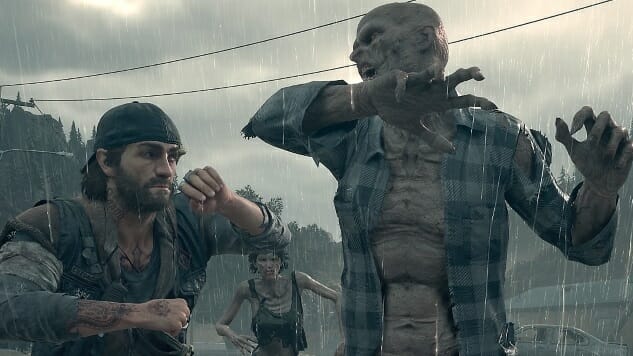I’m Pretty Sure Days Gone Hates Me More Than I Hate It

When Days Gone is loading, a ring spins in the bottom right corner of the screen. It’s one of the most ridiculous rings you’ll ever see, in the real world or a videogame, with a large, silver wolf’s skull on top that covers up at least half of any finger that wears it. It’s jewelry for men who need their jewelry to scream “I’M STILL A MAN!”, as if their masculinity (and its motorcycles, beards and neck tattoos) was somehow undermined by wearing a piece of metal on their hands. I know this ring better than my own wedding ring now, because I’ve had to stare at it for most of my time in Days Gone.
When I launch Days Gone on my PlayStation 4 Pro, I almost immediately get a loading screen that lasts for three minutes. That’s three minutes of a black screen with that tiny ring spinning endlessly in the corner. And that’s not three minutes of loading to get to where I actually am within the game—that’s three minutes just to get to the main title menu, at which point I have to choose to continue my game, and then sit through another loading screen that never runs for less than 90 seconds. If the idea is to make players feel how dull and tedious living in a post-society zombie wasteland must be, then Days Gone accomplishes at least one of its goals.
Much worse than the loading screens, though, is the checkpoint system, or apparent lack thereof. There’s an option on the pause screen to save your game, but I can’t tell why it exists. I saved my game in the middle of a mission multiple times, and even when I had done multiple individual objectives within the mission, loading that save file would put me back at the very beginning, at the same spot captured by the autosave. Perhaps this changes deeper in the game—I did not get that far into this one, which is why this isn’t an official scored review—but it’s incredibly frustrating to have to repeat 30 minutes or more because this game doesn’t save the way games in the year 2019 are expected to save.
Here’s an example. Early on there’s a mission where the sullen survivalist I have to play as (whose name, no joke, is Deacon St. John, and who, again, is a sad, angry biker in a zombie-riddled Oregon, and not a Brontë love interest) goes to pick up his bike, which he had to abandon on the side of a road. While walking through the woods he comes upon a group of human raiders, who, as part of Days Gone’s unthinking fealty to the stereotypes of the post-apocalypse canon, are obviously bad guys who need to be killed as soon as possible. This encounter is basically a tutorial on the game’s stealth mechanics, and if you know anything about stealth in videogames, you know that means it takes more time to get through this fight than if my guy just went in with guns a-blazin’. (I tried that, and yes, I was staring at a post-death loading screen very quickly.) I sneaked and crawled and scurried and killed all these jokers with my knife, and even if they were standing like five in-game feet away, none of them ever caught me in the act.
After those murders I continued down to where my bike was supposed to be. There were zombies just kind of milling about throughout the woods (the game calls them “freakers,” which, yeah), so I guess it’s possible I could’ve had some random fights between that camp and getting to the road. I avoided them, though, and hightailed it to that two-lane blacktop, where my bike was nowhere to be found.
My dude is hip to the ways of the apocalypse, though. Somehow he knew (or maybe guessed) that his bike was picked up for scrap by a local settlement of good, friendly folk who he refuses to live with because then he wouldn’t be a hardened loner with just a bike and a friend with head tats named Boozer. So I head to this group’s makeshift fort, slowly walk around for a bit, and then find the local mechanic, which triggers a cut-scene. After that I have to walk around this little village some more, to go find its leader, which then kicks off another cut-scene where he pressures me into doing various tasks for him. After that cut-scene, and this solid 30 to 40 minute chunk of in-game shenanigans, I had to shut the game down and take care of some real-life obligations. So I went to that menu, chose to save my game, waited like another minute after it seemed to finish saving just to make sure, and then turned off my game box and went out to do anything else.